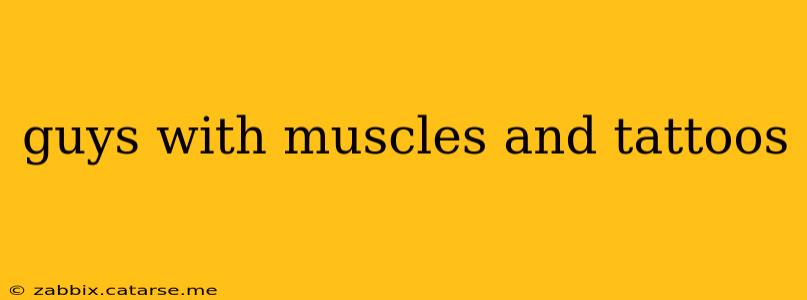The combination of muscular physiques and intricate tattoos has become a powerful visual statement, captivating attention in various spheres, from fitness modeling and bodybuilding to professional sports and the broader realms of art and self-expression. This exploration delves into the multifaceted world of men who choose to adorn their bodies with both physical strength and artistic ink. We'll explore the reasons behind this aesthetic choice, delve into the cultural significance, and address some common questions surrounding this compelling combination.
Why Do Men Combine Muscles and Tattoos?
The reasons behind this compelling pairing are diverse and deeply personal. For many, it's a powerful statement of self-expression. Muscles represent dedication, discipline, and hard work, while tattoos serve as visual narratives, reflecting personal experiences, beliefs, and values. The combination signifies a commitment to both physical and artistic self-improvement. Some view it as a way to push boundaries, challenge societal norms, and express individuality.
What Do Tattoos on Muscular Men Symbolize?
The symbolism of tattoos on muscular men is as varied as the individuals who bear them. Some choose designs that reflect their passions, such as animals, mythical creatures, or symbolic imagery tied to their careers or hobbies. Others opt for tribal designs, geometric patterns, or script tattoos conveying personal mottos or meaningful quotes. The placement of tattoos can also be significant, with larger pieces often highlighting the muscular physique, while smaller, more intricate designs might be strategically placed to accentuate specific muscle groups. The meaning is inherently personal and often deeply layered.
Are Tattoos More Appealing on Muscular Men?
Whether tattoos are "more appealing" is entirely subjective and depends on individual preferences. What one person finds attractive, another might not. However, the combination of a well-defined physique and artistic body art can be visually striking for many. The contrast between the smooth, toned muscles and the textured detail of a tattoo can create a visually impressive aesthetic. The key is the quality of both the physique and the tattoo artistry – both need to be well-executed to achieve a harmonious effect.
How Do Tattoos Affect Muscle Growth?
There's a common misconception that tattoos hinder muscle growth. While the needle penetration during tattoo application can cause minor temporary inflammation, there's no scientific evidence suggesting that tattoos significantly impede muscle growth. Proper aftercare and hygiene are crucial, just as they are for any skin injury, to ensure proper healing and prevent infection. Ultimately, diet, training, and genetics remain the primary factors determining muscle growth.
Where Do Men Typically Get Tattoos?
Tattoo placement on muscular men is highly variable and personal. Popular areas include the chest, back, shoulders, arms, and legs – areas that provide ample canvas for larger, more intricate designs. The placement often complements the muscular definition, enhancing the overall visual impact. However, individuals might choose less prominent areas for more personal or sentimental tattoos.
Are Tattoos More Common Among Muscular Men?
While there's no definitive statistical data on the correlation between muscularity and tattoo prevalence, anecdotal evidence suggests a higher-than-average rate of tattooed individuals within bodybuilding and fitness communities. This might be attributed to the shared interest in self-modification and body art within these groups. However, it's vital to remember that this is a generalization, and many muscular men choose not to have tattoos.
In conclusion, the confluence of muscles and tattoos represents a complex interplay of physical discipline and artistic expression. It's a visual representation of personal values, beliefs, and the pursuit of self-improvement. The aesthetic appeal is subjective, but the significance of this combination remains a captivating area of exploration in the world of body art and physical culture.
